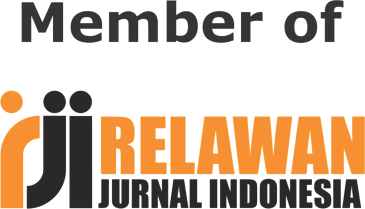Implementation of the Linear Regression Method to Determine Predictions of the Influence of Religion on General Election Participation
Abstract
This research aims to predict election participation in places of worship through statistical data analysis methods and predictive algorithms. Election participation, as a complex phenomenon, is influenced by various factors, with religion often being a crucial element that motivates or inhibits voter turnout. This study uses variables from Central Statistics Agency (BPS) data and recapitulation of previous general elections, based on historical patterns. Using a statistical approach, the relationship between religious variables and the level of voter participation in places of worship is identified. The linear regression method is used to predict the influence of religion on election participation. In this research, a series of scenarios were carried out, and the research results showed different variations in R-squared (R-Square) and Mean Squared Error (MSE) results. The best scenario, namely the R-squared scenario with a value of around 0.00012 and an MSE of 0.09934, highlights the potential relationship between religion and voter participation. These findings suggest the need for further considerations in this context, as well as demonstrating the need for model adjustments to improve the accuracy of future election predictions.
Downloads
References
J. Penelitian, P. Pancasila, D. Kewarganegaraan, and D. N. Ramadhanti, “De Cive: Demokrasi dan Pemilu Indonesia dalam Tinjauan Sosiologi Politik,” vol. 2, no. 9, pp. 361–366, 2022, [Online]. Available: https://doi.org/10.56393/decive.v2i9.1677.
I. P. A. P. Wibawa, I. K. A. Purnawan, D. P. S. Putri, and N. K. D. Rusjayanthi, “Prediksi Partisipasi Pemilih dalam Pemilu Presiden 2014 dengan Metode Support Vector Machine,” J. Ilm. Merpati (Menara Penelit. Akad. Teknol. Informasi), vol. 7, no. 3, p. 182, 2019, doi: 10.24843/jim.2019.v07.i03.p02.
A. Intani, “Pemilu Serentak Tahun 2024: Prediksi Partisipasi Politik Masyarakat Mengacu Pada Perbandingan Anggaran Kampanye Pemilu Serentak Tahun 2019,” Madani J. Ilm. Multidisiplin, vol. 1, no. 8, pp. 1–13, 2023, [Online].
A. S. Fitriani, “Penerapan Data Mining Menggunakan Metode Klasifikasi Naïve Bayes untuk Memprediksi Partisipasi Pemilihan Gubernur,” JTAM (Jurnal Teor. dan Apl. Mat., vol. 3, no. 2, pp. 98–104, 2019. https://doi.org/10.31764/jtam.v3i2.995
O. Samosir and I. Novitasari, “Hak Politik Warga Negara Dalam Cengkeraman Politik Identitas: Refleksi Menuju Pemilu Serentak Nasional Tahun 2024,” J. Ilmu Hukum, Hum. dan Polit., vol. 2, no. 3, pp. 332–346, 2022,. https://doi.org/10.38035/jihhp.v2i3.1052
E. Trianggorowati and R. Al-Hamdi, “Jurnal Tapis: Jurnal Teropong Aspirasi Politik Islam 16 (1) (2020) 65-82,” Strateg. Kampanye Partai Islam Kasus Partai Keadilan Sejah. pada Pemilu 2019, vol. 16 (1), no. 1, pp. 65–82, 2020, [Online]. Available: https://http//ejournal.radenintan.ac.id/index.php/TAPIs/index. http://dx.doi.org/10.24042/tps.v16i1.6814
P. Purwadi, P. S. Ramadhan, and N. Safitri, “Penerapan Data Mining Untuk Mengestimasi Laju Pertumbuhan Penduduk Menggunakan Metode Regresi Linier Berganda Pada BPS Deli Serdang,” J. SAINTIKOM (Jurnal Sains Manaj. Inform. dan Komputer), vol. 18, no. 1, p. 55, 2019, doi: 10.53513/jis.v18i1.104. https://doi.org/10.53513/jis.v18i1.104
Y. Goktua Siadari and D. Saripuna, “Data Mining Untuk Mengestimasi Jumlah Penumpang Pada Pt. Pinem Lau Guna Medan Dengan Menggunakan Metodere Gresi Linear Berganda,” J. CyberTech, vol. x. No.x, no. x, 2020. https://doi.org/10.53513/jct.v4i2.1998
M. C. Pulungan, M. Rahmatunnisa, and A. G. Herdiansyah, “Strategi KPU Kota Bekasi dalam meningkatkan Partisipastif Pemilih Disabilitas,” J. Polit. Islam, vol. 3, no. 2, pp. 251–272, 2020. https://doi.org/10.20414/politea.v3i2.2439
A. N. Latifah, M. Sulistiyono, A. Sidauruk, B. Satria, and M. T. Nurcholis, “Prediksi Curah Hujan Menggunakan Algoritma Regresi Linear Berganda,” vol. 23, pp. 39–44, 2023.
M. Sholeh, R. Y. Rachmawati, and E. N. Cahyo, “Penerapan Regresi Linear Ganda Untuk Memprediksi Hasil Nilai Kuesioner Mahasiswa Dengan Menggunakan Python,” J. Din. Inform., vol. 11, no. 1, pp. 13–24, 2022, [Online]. Available: https://jdi.upy.ac.id/index.php/jdi/article/view/124.
Achmad Saiful Rizal and Moch. Lutfi, “Prediksi Hasil Pemilu Legislatif Menggunakan Algoritma K-Nearest Neighbor Berbasis Backward Elimination,” J. Resist. (Rekayasa Sist. Komputer), vol. 3, no. 1, pp. 27–41, 2020, doi: 10.31598/jurnalresistor.v3i1.517. https://doi.org/10.31598/jurnalresistor.v3i1.517
M. P. Handayani, A. Azhar, and V. C. G. Hura, “Perhitungan Nilai Ekivalensi Mobil Penumpang Dengan Metode Regresi Linier Berganda Pada Ruas Jalan Thamrin Kota Padang,” Ekasakti J. Penelit. Pengabdi., vol. 2, no. 2, pp. 106–121, 2022. https://doi.org/10.31933/ejpp.v2i2.545
D. Selent, T. Patikorn, and N. Heffernan, “ASSIStments dataset from multiple randomized controlled experiments,” L@S 2016 - Proc. 3rd 2016 ACM Conf. Learn. Scale, pp. 181–184, 2016, doi: 10.1145/2876034.2893409.
S. V., S. Chandurkar, and S. Bansode, “Attribute Selection to Improve Accuracy of Classification,” Int. J. Comput. Appl., vol. 173, no. 5, pp. 18–22, 2017, doi: 10.5120/ijca2017915117.
Y. S. Bhakti, A. B. Kusdinar, and A. A. Sunarto, “Model Peramalan Penerimaan Calon Mahasiswa Menggunakan Metode Regresi,” Progresif J. Ilm. Komput., vol. 16, no. 2, p. 113, 2020, doi: 10.35889/progresif.v16i2.515.
A. A. Khan, “Balanced Split: A new train-test data splitting strategy for imbalanced datasets,” 2022, [Online]. Available: http://arxiv.org/abs/2212.11116. https://doi.org/10.48550/arXiv.2212.11116
G. N. Ayuni and D. Fitrianah, “Penerapan metode Regresi Linear untuk prediksi penjualan properti pada PT XYZ,” J. Telemat., vol. 14, no. 2, pp. 79–86, 2019, [Online]. Available: https://doi.org/10.61769/telematika.v14i2.321
Copyright (c) 2024 Digital Zone: Jurnal Teknologi Informasi dan Komunikasi

This work is licensed under a Creative Commons Attribution-ShareAlike 4.0 International License.











